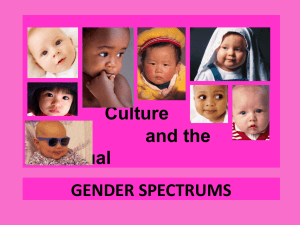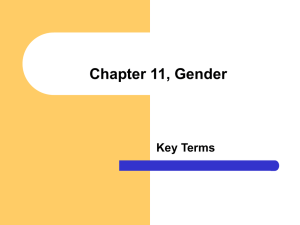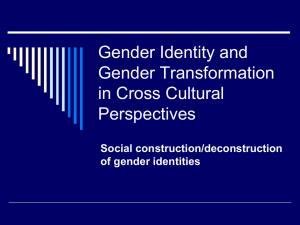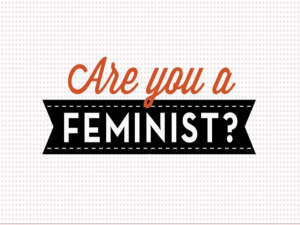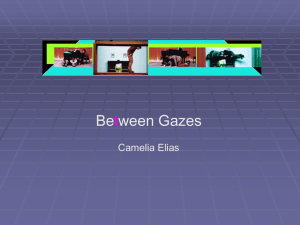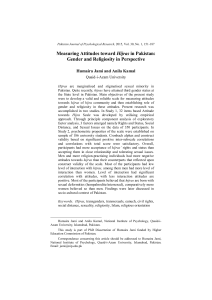PPT
advertisement
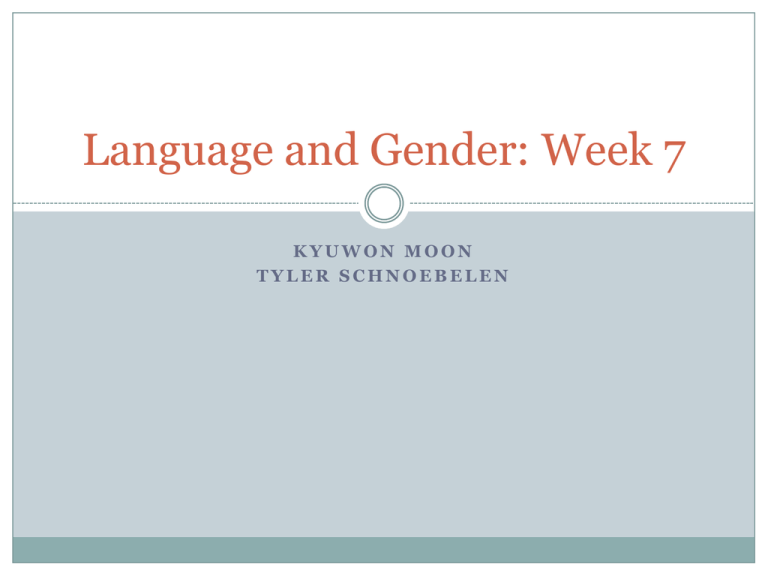
Language and Gender: Week 7 KYUWON MOON TYLER SCHNOEBELEN Today’s plan Hijra’s language Chatper 7 Categories and labels Patrolling boundaries Default categories & markedness Class stuff Hijra’s sexual insults Hall (1997), “Go suck your husband’s sugarcane!” On Hijra’s curses and sexual insults “Hijras aren’t counted as women, after all. Hijras are just hijras, and women are just women. If there’s a woman, she will at least have a little shame…… But hijras are just hijras. They have no shame. They’ll say whatever they have to say.” (Nonhijra, 1993) “We’ll give curses like women. We don’t give manly curses.” (hijra, 1993) Respect and solidarity Hijra’s curse “You worthless fool, good-for-nothing, son-of-a-bastard, may your wife be eaten by a dog, may you be dark-faced, may god shower calamities on you, you widower!” Why curse? To others: to reclaim respect Between themselves: to achieve solidarity Categorizing These ambiguities, redundancies, and deficiencies recall those attributed by Dr. Franz Kuhn to a certain Chinese encyclopedia called the Heavenly Emporium of Benevolent Knowledge. In its distant pages it is written that animals are divided into Types of animals (a) those that belong to the emperor; (b) embalmed ones; (c) those that are trained; (d) suckling pigs; (e) mermaids; (f) fabulous ones; (g) stray dogs; (h) those that are included in this classification; (i) those that tremble as if they were mad; (j) innumerable ones; (k) those drawn with a very fine camel's-hair brush; (l) etcetera; (m) those that have just broken the flower vase; (n) those that at a distance resemble flies. What is this? And this? …And this? Categories are social constructs … and labels, too! Patrolling boundaries Who you asks matters Eggplant to a botanist vs. a cook But some folks have more authority than others And there are lots of forces enforcing the sanctity of social categories I’m not a feminist, but… Risks of saying “I’m a feminist” Feminism: disparaged category What will come after “but”? Feminism (Wikipedia) “Feminism is the idea that women should have political, social, sexual, intellectual, and economic rights equal to those of men.” People on the Border Categories under categories Marginalized categories Centrality: Some members are better examples than others (birth mothers vs. adoptive mothers vs. working mothers?) Feminism only for middle-class white women? Being African American gay man (Barret 1999) But, who isn’t? Who is not on the border? I’m on the border because I am… - Asian - Grad student - Non-native speaker of English - Female - Married - And many more A rose by any other name… …would smell as sweet? Euphemism treadmill (Pinker) Words originally intended as euphemisms may lose their euphemistic value, acquiring the negative connotations of their referents negro → colored → black → African-American idiot/moron (originally neutral!) → retarded → mentally challenged/special Gender neutralization Examples: Stewardess→Flight attendant He→They Policeman→Police officer Chairman→Chairperson Le professeur→La proffeseure But there are no linguistic quick fixes Change isn’t always smooth You can’t control words once you put them out in the world (e.g., politically correct) Then, why should we bother? Gastil (1990)’s results Males still produce more male images even with “they” pronoun But… “Changing schemes for categorization and changing labels are part of changing social practice” (E&M-G 2003: 265). If we still have time… Gendered metaphor Vowels are feminine, consonants are masculine: sound symbolism Just random? Vowels: [+sonorant], consonants: [-sonorant] (with exception of [m,n,l,ng]) Sonorant sounds are soft, deep, and resonant: traits that are considered to be “feminine” “Father gives birth to a baby and mother raises the baby.” What I learned from elementary school Habitus?
